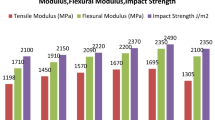Abstract
The shrinkage of vinyl ester particulate composites has been reduced by curing the resins under microwave conditions. The reduction in the shrinkage of the resins by microwaves will enable the manufacture of large vinyl ester composite items possible (H.S. Ku, G. Van Erp, J.A.R. Ball, and S. Ayers, Shrinkage Reduction of Thermoset Fibre Composites during Hardening using Microwaves Irradiation for Curing, Proceedings, Second World Engineering Congress, Kuching, Malaysia, 2002a, 22-25 July, p 177-182; H.S. Ku, Risks Involved in Curing Vinyl Ester Resins Using Microwaves Irradiation. J. Mater. Synth. Proces. 2002b, 10(2), p 97-106; S.H. Ku, Curing Vinyl Ester Particle Reinforced Composites Using Microwaves. J. Comp. Mater., (2003a), 37(22), p 2027-2042; S.H. Ku and E. Siores, Shrinkage Reduction of Thermoset Matrix Particle Reinforced Composites During Hardening Using Microwaves Irradiation, Trans. Hong Kong Inst. Eng., 2004, 11(3), p 29-34). In tensile tests, the yield strengths of samples cured under microwave conditions obtained are within 5% of those obtained by ambient curing; it is also found that with 180 W microwave power, the tensile strengths obtained for all duration of exposure to microwaves are also within the 5% of those obtained by ambient curing. While, with 360 W microwave power, the tensile strengths obtained for all duration of exposure to microwaves are 5% higher than those obtained by ambient curing. Whereas, with 540 W microwave power, the tensile strengths obtained for most samples are 5% below those obtained by ambient curing (H. Ku, V.C. Puttgunta, and M. Trada, Young’s Modulus of Vinyl Ester Composites Cured by Microwave Irradiation: Preliminary Results, J. Electromagnet. Waves Appl., 2007, 20(14), p. 1911-1924). This project, using 33% by weight fly ash reinforced vinyl ester composite [VE/FLYSH (33%)], is to further investigate the difference in fracture toughness between microwave cured vinyl ester particulate composites and those cured under ambient conditions. Higher power microwaves, 540 and 720 W with shorter duration of exposure are used to cure the composites. Short-bar method of fracture toughness measurement was used to perform the tests. Plastic (PVC) re-usable molds were designed and manufactured for producing the test samples. The results show that the fracture toughness of specimens cured by microwave conditions are generally higher than those cured under ambient conditions, provided the power level and duration of microwave irradiation are properly and optimally selected.






Similar content being viewed by others
References
S.T. Peters, Ed., Handbook of composites. Chapman and Hall, 1998, p 40–42
G. Lubin, Ed., Handbook of Composites. Van Nostrand Reinhold, 1982, p 45–47
D.R. Askeland, The Science and Engineering of Materials, 3rd ed., Stanley Thornes, 1998, p 163–164
L.M. Barker, Fracture Mechanics Applied to Brittle Materials, ASTM, STP 678, American Society for Testing and Materials, 1979, p 73–82
L.M. Baker, Development of the Short Road Method of Fracture Toughness Measurement, Proceedings, Conference on Wear and Fracture Prevention, 21–22 May, ASM, Metals Park, Ohio, 1980, p 163–180
L.M. Baker, Short Rod and Short Bar Fracture Toughness Specimen Geometries and Test Methods for Metallic Materials, Proceedings, Fracture Mechanics: Thirteenth Conference, ASMT STP 743, 1981, p 456–475
Ku H., Tsang S.H., Baddeley D., Snook C. (2006) Short Bar Tests for Vinyl Ester Particulate Reinforced Composites Cured by Microwaves. Aust. J. Struct. Eng. 7(1):65–73
Chew C.S., Ku H., Snook C., Baddeley D. (2004) Micrographs of the Fracture of Vinyl Ester Composites Cured by Microwaves: Pilot Study. J. Electromagnet. Waves Appl. 19(1):67–82
W.D. Callister, Materials Science and Engineering: An Introduction, 7th ed., John Wiley and Sons, Inc., 2006, p 201–203
B.T. Astrom, Manufacturing of Polymer Composites, Chapman and Hall, 1997, p 74–83, 432–434
S.H. Ku and E. Siores, Shrinkage Reduction of Thermoset Matrix Particle Reinforced Composites During Hardening Using Microwaves Irradiation, Trans. Hong Kong Inst. Eng., 2004, 11(3), p 29-34
H.S. Ku, G. Van Erp, J.A.R. Ball, and S. Ayers, Shrinkage Reduction of Thermoset Fibre Composites during Hardening using Microwaves Irradiation for Curing, Proceedings, Second World Engineering Congress, Kuching, Malaysia, 2002a, 22–25 July, p 177–182
Ku H.S. (2002b) Risks involved in curing vinyl ester resins using microwaves irradiation. J. Mater. Synth. Proces. 10(2):97–106
Ku S.H. (2003a) Curing Vinyl Ester Particle Reinforced Composites Using Microwaves. J. Comp. Mater. 37(22):2027–2042
Munz D. (1981) Determination of Fracture Toughness of High Strength Aluminum Alloys with Cheron Notched Short Rod and Short Bar Specimens. Eng. Fracture Mech. 15(1–2):231–236
Author information
Authors and Affiliations
Corresponding author
Rights and permissions
About this article
Cite this article
Ku, H., Chan, W., Trada, M. et al. An Evaluation of Fracture Toughness of Vinyl Ester Composites Cured under Microwave Conditions. J. of Materi Eng and Perform 16, 741–745 (2007). https://doi.org/10.1007/s11665-007-9104-5
Received:
Revised:
Accepted:
Published:
Issue Date:
DOI: https://doi.org/10.1007/s11665-007-9104-5




